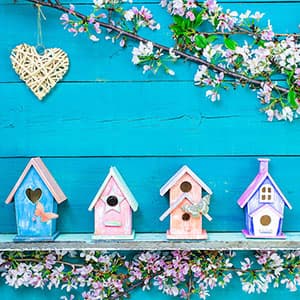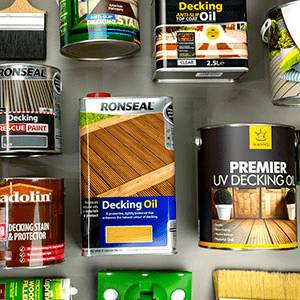Log Cabin Treatment FAQ's
I would like to add colour to my log cabin. What can I use?
There are many ways to colour the exterior of a log cabin depending on the colour and type of finish required. New or previously untreated log cabins can be coloured with a pigmented wood preserver such as Barrettine Premier Wood Preservative, then sealed with a clear exterior wood oil such as Barrettine Log Cabin Treatment. This will provide excellent weather protection and is easily maintained year after year by simply applying a maintenance coat of log cabin treatment. An alternative approach is to use a clear exterior wood preservative such as Barrettine Premier Wood Preservative then overcoat with a coloured exterior wood oil suitable for log cabins, again very easy to apply and maintain year on year.
An alternative approach to wood oils is to use either a clear or coloured exterior varnish or an exterior garden paint such as Cuprinol Garden Shades or Ronseal Garden Paint.
Are log cabins made out of real logs?
In this country, log cabins typically don't look like the log cabins made from whole or half cut logs. Log cabins are usually bigger than a typical shed and are made from thicker lengths of timber than a garden shed. They are structurally stronger and better insulated making them perfect for use as an external dwelling if required. Sometimes log cabins are referred to as summer houses and vice versa.
My log cabin is turning green around the base. What can I do?
This sounds like biological growth of mould, mildew or algae and is often the result of damp conditions. To clean this and help prevent occurrence in the future we recommend the following. Scrape off as much surface growth as possible with a paint scraper, stiff brush or broom. Use Barrettine Mould and Mildew Cleaner to clean off any remaining growth, this product will also kill off any remaining mould or algae spores in the surface of the wood. Two treatments may be required if the log cabin timbers are heavily soiled.
For new or untreated log cabins, follow the above then treat with 2 coats of Barrettine Premier Wood Preservative which will help protect the wood from future biological growth and woodworm etc. Finally treat with Barrettine Log Cabin Treatment which will protect the wood from moisture and water ingress.
I have a new log cabin. Can I stop the wood turning grey?
Exterior wood naturally turns grey over time as a result of sun and water damage. The best way to protect the timber from turning grey is to use a coloured wood oil such as Holzol Weather Oil. The combination of UV filters and coloured pigments in the oil help to reduce the bleaching effects of the sun whilst nourishing the timber This helps to keep the wood supple therefore helping to prevent cracking, warping and splitting of the wood fibres.
If a clear finish is desired, use a clear decking oil such as Manns Premier UV Decking Oil or Barrettine Decking Oil. These products contain UV filters or stabilisers and will slow down the damaging effects of sun and water damage, much like a sun tan cream does for skin. Although these products slow down the bleaching and discoloration of the natural wood colour they will not stop it completely.
Using a lightly pigmented or coloured wood oil offers better protection than a clear finish. This said, maintaining the oil with a fresh maintenance coat each year will help to maintain the colour of the final finish.
Can I protect the interior floor and walls of my log cabin?
The wooden floor of a log cabin can be protected and sealed like any wooden floor with a floor oil or floor varnish. This will help to protect the floor and prevent dirt, grime and moisture from penetrating into the wood and ruining it over time. Finishing the floor also makes them easier to clean and maintain.
Interior walls and ceiling can be oiled, varnished or painted to personal preference. This again protects the wood from dirt and moisture making the interior of log cabin easier to clean and maintain.
My log cabin has turned grey/silver in colour. What can I do?
Exterior wood naturally turns grey or silver over time (especially Oak, Iroko and Idigbo) as a result of sun and water damage. This happens fastest with unprotected or bare wood, or wood that has been treated with a clear wood finish that doesn't contain any UV filters or stabilisers.
For a bare wood log cabin or one that hasn't been treated for a number of years, the natural colour of the wood can be restored by using Osmo Wood Reviver Gel (6609). This product must be scrubbed into the surface of the wood with a scotch pad, stiff brush or other abrasive pad. After around 20 minutes, the gel must be rinsed off with lots of clean water. The natural colour of the wood will start to return within a couple of hours but can take up to 24 hours. For wood that has been grey for a long time, a second application and rinse down may be required.
I want to treat the interior walls of a log cabin. It will be used occasionally for teenagers to sleep in. I want something that isn't highly flammable or has strong odours. The size is 5.5 x 3.5 metres. It is brand new.
None of the products we supply will be flammable once applied and cured, it is only solvent-based products that when in their liquid state need to be kept away from flames etc. If you are unsure, it's worth checking the product data sheets for relevant information.
For the interior of a Log Cabin we often recommend products like Fiddes Hard Wax Oil or Osmo Polyx Oil, for a natural look and feel to the wood. Hard Wax Oils are durable, liquid repellent and resistant to dirt, dust and other marks. They work by penetrating into the surface of the wood and oxidising with the air to form a highly durable yet easy to apply, maintain and repair finish. These types of products tend to have a high V.O.C (volatile organic compounds) content so will be smelly when first applied. Always allow for good ventilation during application and drying. The solvents used in these products will evaporate and disperse over a week to leave a tough, durable yet perfectly safe finish. Hard wax oils are often used on wooden toys, kitchen worktops and other food preparation surfaces. They also have excellent coverage, a small amount goes a long way and only requires 2 thin coats.
Clear hard wax oils tend to darken the wood giving it an almost damp like appearance. They also tend to enhance the natural colour and character of the wood grain which in the case of pine can be golden or a yellowy orange colour. To better retain the natural untreated appearance of the wood, consider the raw or natural versions. Links below...
It's important to note that Hard Wax Oils are not suitable for exterior use such as on the outside of sheds and log cabins.
Sample sizes are available and test areas are recommended to assess the final finish before starting any project.
Do I need to treat the interior of my Log Cabin with Preservative?
It is not necessary but if a preservative is required or desired, use a biocide free preserver such as Osmo Wood Protector (4006).
The inside of log cabins can be treated the same as the inside of a property, with interior floor oils or floor varnishes. These products can also be used on the walls and ceiling if required to achieve a desired finish and protect surfaces from dirt, dust and moisture. For some product suggestions, see our wall and ceiling finishes page and our floor finishes page.
What is the best treatment for a log cabin?
This is a difficult question as knowing which log cabin treatment is best can depend on the type of finish required, appearance, budget, log cabin condition, location and more.
For a clear finish, Barrettine Log Cabin Treatment is the perfect choice for new or bare wood log cabins. It's made from a blend of oils, waxes and resins that provide a durable and extremely weather resistant finish. This product provides an extra layer of protection for previously preserved or pressure treated timbers. For bare timbers, we recommend first treating with Barrettine Mould and Mildew Cleaner to remove any biological growth, then treating wood with Barrettine Premier Universal Preservative to help protect against mould, algae growth and wood boring insects. The log cabin can then be finished with a clear exterior wood oil such as Barrettine Log Cabin Treatment.
If a coloured finish is preferred, consider Holzol Weather Oil. This product is available in a range of attractive colours and provides excellent protection against the elements. For more natural wood tone colours, consider Manns Premier UV Decking Oil or Barrettine Decking Oil.
Log cabins in exposed environments and that are subjected to extreme weathering can be first treated with Cuprinol 5 Star Complete Wood Treatment (WB) then coated with Sikkens Cetol HLS Plus followed by Sikkens Cetol Filter 7 Plus.
Log Cabin Treatments
Related Log Cabin blog posts
Disclaimer: Whilst every attempt has been made to provide product information that is as accurate as possible, it's important to clarify that trees and the wood that they produce can be affected by many factors. For example, the same species of tree grown in the same wood, even in close proximity, will be affected by age along with the amount of sunlight and water they receive. Other naturally occurring biological and environmental factors will also influence the density and grain of the wood as well as the moisture and oil content of the timber. No two trees are the same, meaning each piece of wood has the potential to look and react differently to the same wood finish. For example, product adhesion, colour variations, absorption rates and sheen levels. It is for this reason that we always strongly recommend carrying out test areas before starting any project


